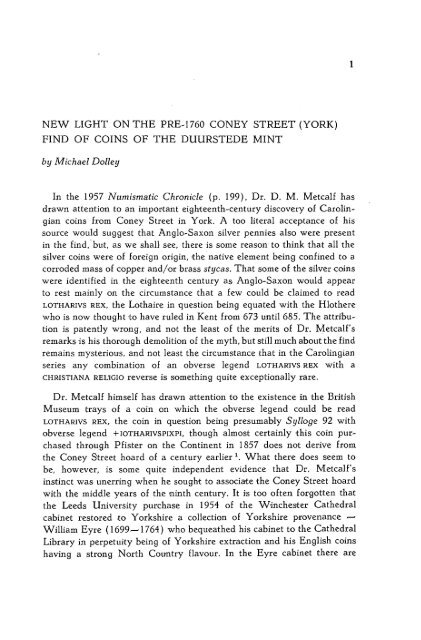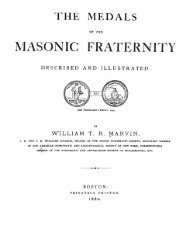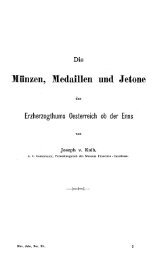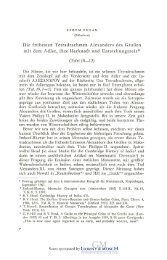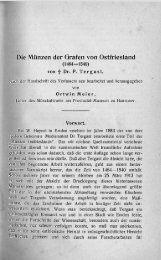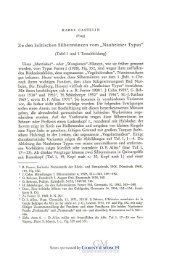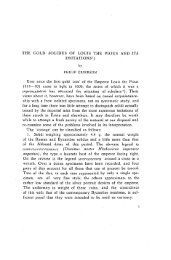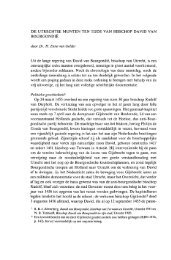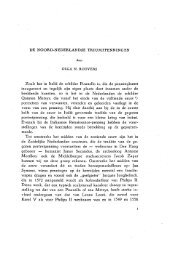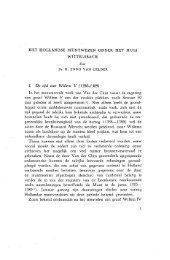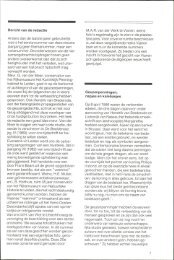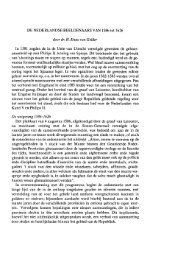New light on the pre-1760 Coney Street (York) find of coins of the ...
New light on the pre-1760 Coney Street (York) find of coins of the ...
New light on the pre-1760 Coney Street (York) find of coins of the ...
You also want an ePaper? Increase the reach of your titles
YUMPU automatically turns print PDFs into web optimized ePapers that Google loves.
NEW LIGHT ON THE PRE-<strong>1760</strong> CONEY STREET (YORK)<br />
FIND OF COINS OF THE DUURSTEDE MINT<br />
by Michael Dolley<br />
In <strong>the</strong> 1957 Nwnismatic Chr<strong>on</strong>icle (p. 199), Dr. D. M. Metcalf has<br />
drawn attenti<strong>on</strong> to an important eighteenth-century discovery <strong>of</strong> Carolingian<br />
<strong>coins</strong> from C<strong>on</strong>ey <strong>Street</strong> in <strong>York</strong>. A too literal acceptance <strong>of</strong> his<br />
source would suggest that Anglo-Sax<strong>on</strong> silver pennies also were <strong>pre</strong>sent<br />
in <strong>the</strong> <strong>find</strong>,'but, as we shall see, <strong>the</strong>re is some reas<strong>on</strong> to think that all <strong>the</strong><br />
silver <strong>coins</strong> were <strong>of</strong> foreign origin, <strong>the</strong> native element being c<strong>on</strong>fined to a<br />
corroded mass <strong>of</strong> copper and/or brass styca.. That some <strong>of</strong> <strong>the</strong> silver <strong>coins</strong><br />
were identified in <strong>the</strong> eighteenth century as Anglo-Sax<strong>on</strong> would appear<br />
to rest mainly <strong>on</strong> <strong>the</strong> circumstance that a few could be claimed to read<br />
LOTHARIVS REX <strong>the</strong> Lothaire in questi<strong>on</strong> being equated with <strong>the</strong> Hlo<strong>the</strong>re<br />
who is now thought to have ruled in Kent from 673 until 685 The attributi<strong>on</strong><br />
is patently wr<strong>on</strong>q and not <strong>the</strong> least <strong>of</strong> <strong>the</strong> merits <strong>of</strong> Dr Metcalfs<br />
remarks is his thorough demoliti<strong>on</strong> <strong>of</strong> <strong>the</strong> myth but still much about <strong>the</strong> <strong>find</strong><br />
remains mysterious and not least <strong>the</strong> circumstance that in <strong>the</strong> Carolingian<br />
series any combinati<strong>on</strong> <strong>of</strong> an obverse legend LOTHARIVS REX with a<br />
CHRISTIANA RELIGIO reverse is something quite excepti<strong>on</strong>ally rare.<br />
Dr. Metcalf himself has drawn attenti<strong>on</strong> to <strong>the</strong> existence in <strong>the</strong> British<br />
Museum trays <strong>of</strong> a coin <strong>on</strong> which <strong>the</strong> obverse legend could be read<br />
LOTHARIVS REX, <strong>the</strong> coin in questi<strong>on</strong> being <strong>pre</strong>sumably Sytloge 92 with<br />
obverse legend + IOTHARIVSPIXPI, though almost certainly this coin purchased<br />
through Pfister <strong>on</strong> <strong>the</strong> C<strong>on</strong>tinent in 1857 does not derive from<br />
<strong>the</strong> C<strong>on</strong>ey <strong>Street</strong> hoard <strong>of</strong> a century earlier \ What <strong>the</strong>re does seem to<br />
be, however, is some quite independent evidence that Dr. Metcalfs<br />
instinct was unerring when he sought to associate <strong>the</strong> C<strong>on</strong>ey <strong>Street</strong> hoard<br />
with <strong>the</strong> middle years <strong>of</strong> <strong>the</strong> ninth century. It is too <strong>of</strong>ten forgotten that<br />
<strong>the</strong> Leeds University purchase in 1954 <strong>of</strong> <strong>the</strong> Winchester Ca<strong>the</strong>dral<br />
cabinet restored to <strong>York</strong>shire a collecti<strong>on</strong> <strong>of</strong> <strong>York</strong>shire provenance -<br />
William Eyre (1699-1764) who bequea<strong>the</strong>d his cabinet to <strong>the</strong> Ca<strong>the</strong>dral<br />
Library in perpetuity being <strong>of</strong> <strong>York</strong>shire extracti<strong>on</strong> and his English <strong>coins</strong><br />
having a str<strong>on</strong>g North Country flavour. In <strong>the</strong> Eyre cabinet <strong>the</strong>re are<br />
1
2 MICHAEL DOLLEY<br />
<strong>pre</strong>cisely 5 Carolingian <strong>coins</strong>. One is an obolus <strong>of</strong> Melle <strong>of</strong> a type that<br />
is usually associated with Charles <strong>the</strong> Bald, and seems a little later in<br />
date than <strong>the</strong> remaining 4 <strong>coins</strong> which are all denarii. It is not impossible,<br />
<strong>the</strong>n, that <strong>the</strong> obolus should derive from a late ninth- or early tenthcentury<br />
hoard, and <strong>on</strong>e has <strong>on</strong>ly to glance at <strong>the</strong> Cuerdale hoard to realize<br />
to what extent <strong>the</strong>se later issues <strong>of</strong> Melle circulated am<strong>on</strong>g <strong>the</strong> Viking<br />
c<strong>on</strong>temporaries <strong>of</strong> ^lfred <strong>the</strong> Great (870-901) and Edward <strong>the</strong> Elder<br />
(901-924). It is <strong>the</strong> 4 denarii, however, which <strong>pre</strong>sent a pattern as<br />
remarkable as excepti<strong>on</strong>al. There are 2 which are <strong>of</strong> Louis <strong>the</strong> Pious<br />
(806-840) or, more accurately perhaps, bear his name, and both bel<strong>on</strong>g<br />
to <strong>the</strong> CHRISTIANA RELIGIO issue [Figs. a & b].<br />
The first coin is noteworthy for its omissi<strong>on</strong> <strong>of</strong> all title, but <strong>the</strong> full<br />
implicati<strong>on</strong>s <strong>of</strong> this will be discussed by Pr<strong>of</strong>. K. F. Morris<strong>on</strong> elsewhere,<br />
and are not strictly relevant to <strong>the</strong> <strong>the</strong>me <strong>of</strong> <strong>the</strong> <strong>pre</strong>sent note. It is interesting<br />
to note, though, that Dr. H. Enno van Gelder suggests that <strong>the</strong><br />
phenomen<strong>on</strong> is <strong>on</strong>e c<strong>on</strong>nected with <strong>the</strong> Lower Rhine and with Trier<br />
in particular. The remaining 2 <strong>coins</strong> both purport to be <strong>of</strong> Lothaire I<br />
(840-855), and, though <strong>of</strong> different types, both have <strong>the</strong> mint-signature<br />
<strong>of</strong> Duurstede [Figs. c 6 d]. It is indeed difficult not to c<strong>on</strong>clude that<br />
all 4 <strong>coins</strong> derive from <strong>on</strong>e and <strong>the</strong> same <strong>find</strong> when <strong>the</strong> provenance is so<br />
early, and <strong>the</strong> im<strong>pre</strong>ssi<strong>on</strong> given that all may have been struck in <strong>the</strong> same<br />
general area and at about <strong>the</strong> same time. One may even go fur<strong>the</strong>r<br />
inasmuch as <strong>find</strong>s <strong>of</strong> Carolingian <strong>coins</strong> from Great Britain and Ireland<br />
in which ninth-century <strong>coins</strong> <strong>pre</strong>dominate are far from comm<strong>on</strong>, and,<br />
stressing <strong>the</strong> fact that Eyre was collecting at <strong>the</strong> right date and had<br />
<strong>York</strong>shire c<strong>on</strong>necti<strong>on</strong>s, claim that <strong>the</strong> obvious provenance for <strong>the</strong> 4 denarii<br />
in <strong>the</strong> Eyre cabinet is <strong>the</strong> C<strong>on</strong>ey <strong>Street</strong> hoard from <strong>York</strong> discovered in or<br />
shortly before <strong>1760</strong>.
CONEY STREET (YORK) FIND 3<br />
The publicati<strong>on</strong> <strong>of</strong> <strong>the</strong> British Museum Sylloge <strong>of</strong> Carolingian Coins<br />
means that <strong>the</strong>re is now available an additi<strong>on</strong>al argument in support <strong>of</strong><br />
<strong>the</strong> hypo<strong>the</strong>sis that <strong>the</strong> compositi<strong>on</strong> <strong>of</strong> <strong>the</strong> C<strong>on</strong>ey <strong>Street</strong> <strong>find</strong> was what <strong>the</strong><br />
assumpti<strong>on</strong> that <strong>the</strong> Eyre denarii derive from it might lead us to expect.<br />
In 1818 <strong>the</strong> English Nati<strong>on</strong>al Collecti<strong>on</strong> was fortunate enough to receive<br />
<strong>the</strong> so-called Banks Collecti<strong>on</strong>, a particularly choice cabinet <strong>of</strong> <strong>coins</strong> <strong>of</strong><br />
many periods and countries which had been built up over a number <strong>of</strong><br />
years by <strong>the</strong> wife and sister <strong>of</strong> <strong>the</strong> celebrated Sir Joseph Banks (1783^-<br />
1820) Of <strong>the</strong>ir <strong>coins</strong> 38 are Carolingian and <strong>the</strong> following table shows<br />
how <strong>the</strong>y are divided chr<strong>on</strong>ologically <strong>the</strong> first figure in each line giving<br />
<strong>the</strong> actual number <strong>of</strong> pieces under each head while <strong>the</strong> percentage in <strong>the</strong><br />
sec<strong>on</strong>d column re<strong>pre</strong>sents <strong>the</strong> proporti<strong>on</strong> which <strong>the</strong> aforesaid total bears<br />
to <strong>the</strong> British Museum's <strong>pre</strong>sent holding <strong>of</strong> <strong>coins</strong> <strong>of</strong> <strong>the</strong> class in questi<strong>on</strong>:<br />
Pippin & Charlemagne 2 7,4 %<br />
Louis <strong>the</strong> Pious 14 26.0 %<br />
Lothaire I * 5 41.7 %<br />
All later reigns 17 6.8%<br />
* including some pieces certainly posthumous.<br />
Granted that <strong>the</strong> British Museum collecti<strong>on</strong> is dominated by a selecti<strong>on</strong><br />
as judicious as extensive from <strong>the</strong> great Cuerdale hoard <strong>of</strong> 1840, this<br />
weight <strong>of</strong> <strong>coins</strong> <strong>of</strong> Louis <strong>the</strong> Pious and <strong>of</strong> Lothaire I in <strong>the</strong> Banks cabinet<br />
must surely be deemed likewise to reflect <strong>the</strong> accident <strong>of</strong> discovery. That<br />
<strong>the</strong> source should be <strong>on</strong>ce again <strong>the</strong> eighteenth-century C<strong>on</strong>ey <strong>Street</strong><br />
hoard from <strong>York</strong> may seem suggested very str<strong>on</strong>gly by <strong>the</strong> following<br />
table which breaks down <strong>the</strong> Banks <strong>coins</strong> <strong>of</strong> Louis <strong>the</strong> Pious and <strong>of</strong><br />
Lothaire into <strong>the</strong> following groups:<br />
Christiana O<strong>the</strong>r<br />
Duurstede Religio types<br />
Louis <strong>the</strong> Pious 1 4 9<br />
Lothaire I 3 1 1<br />
Surely it cannot be coincidence that almost exactly half <strong>of</strong> <strong>the</strong> Banks<br />
<strong>coins</strong> in <strong>the</strong> names <strong>of</strong> <strong>the</strong>se rulers bel<strong>on</strong>g to <strong>the</strong> two classes which already<br />
<strong>the</strong>re was reas<strong>on</strong> to associate with <strong>the</strong> C<strong>on</strong>ey <strong>Street</strong> <strong>find</strong>, and it may not<br />
seem too far-fetched a suppositi<strong>on</strong> that this <strong>York</strong> provenance attaches to<br />
most if not all <strong>of</strong> <strong>the</strong> <strong>coins</strong> recorded in <strong>the</strong> first two columns.
4 MICHAEL DOLLEY<br />
There is a temptati<strong>on</strong>, indeed, to carry this line <strong>of</strong> argument yet fur<strong>the</strong>r<br />
where <strong>the</strong> English Nati<strong>on</strong>al Collecti<strong>on</strong> is c<strong>on</strong>cerned. For example, <strong>the</strong>re<br />
is still ano<strong>the</strong>r Louis <strong>the</strong> Pious coin ex Banks which is <strong>of</strong> Christiana<br />
Religio type, an obolus (Sylloge 74), while ano<strong>the</strong>r eighteenth-century<br />
cabinet, that <strong>of</strong> Charles Townley (1737-1800) is <strong>the</strong> source <strong>of</strong> no fewer<br />
than 5 denarii <strong>of</strong> <strong>the</strong> selfsame issue (Sylloge 52-55 and 76) Am<strong>on</strong>g <strong>the</strong><br />
Lothaire <strong>coins</strong>, too, <strong>the</strong>re is a Duurstede denarius (Sylloge 83) which<br />
might well go back to an eighteenth-century origin but <strong>the</strong> <strong>pre</strong>sent writer<br />
would <strong>pre</strong>fer not to spoil what it is hoped may be thought a good case by<br />
special pleading. There is nothinq for example in our original authorities<br />
to suggest that <strong>the</strong> silver <strong>coins</strong> found at C<strong>on</strong>ey <strong>Street</strong> were not all <strong>of</strong> <strong>on</strong>e<br />
and <strong>the</strong> same denominati<strong>on</strong> while <strong>the</strong> Townley <strong>coins</strong> were much more<br />
plausibly acquired by him <strong>on</strong> <strong>the</strong> C<strong>on</strong>tinent and may be supposed to<br />
reflect an antiquarian interest in <strong>the</strong> str<strong>on</strong>gly classical tvoe <strong>of</strong> <strong>the</strong> reverse<br />
Significantly too <strong>the</strong>re are no particular affinities <strong>of</strong> style with <strong>the</strong> <strong>coins</strong><br />
beheved to be from <strong>the</strong> C<strong>on</strong>ey <strong>Street</strong> hoard and <strong>the</strong>y aooear to bel<strong>on</strong>g<br />
to a quite different period and milieu The Lothaire coin indeed although<br />
<strong>of</strong> suspidously low weight is <strong>the</strong> <strong>on</strong>ly piece additi<strong>on</strong>al to <strong>the</strong> Banks <strong>coins</strong><br />
which could possibly derive from <strong>the</strong> <strong>York</strong> <strong>find</strong> in questi<strong>on</strong> and even its<br />
acceptance as such scarcely adds substantial snnnort to a W <strong>of</strong> argument<br />
which must stand or fall <strong>on</strong> very much more judicious <strong>pre</strong>mises<br />
The prime suggesti<strong>on</strong> <strong>of</strong> this note, <strong>the</strong>n, is that we can now be reas<strong>on</strong>ably<br />
certain that <strong>the</strong> Lothaire <strong>coins</strong> found in or shortly before <strong>1760</strong> at<br />
C<strong>on</strong>ey <strong>Street</strong> m <strong>York</strong> were <strong>of</strong> a class more or less firmly associated with<br />
Lothaire I though in part at least posthumous. Accordingly <strong>the</strong>re must<br />
now be made some minor modificati<strong>on</strong>s <strong>of</strong> <strong>the</strong> attributi<strong>on</strong>s which were<br />
suggested by Dr. Metcalf in his original publicati<strong>on</strong>, and by Pr<strong>of</strong>essor<br />
Morris<strong>on</strong> and <strong>the</strong> <strong>pre</strong>sent writer in <strong>the</strong>ir 1964 listing (BNJ 32 (1963),<br />
PP 75-87) <strong>of</strong> those hoards from Great Britain and Ireland which are <strong>on</strong><br />
record as c<strong>on</strong>taining <strong>on</strong>e or more Carolingian <strong>coins</strong> though it should<br />
perhaps be pointed out that in nei<strong>the</strong>r case was <strong>the</strong> Lothaire II attributi<strong>on</strong><br />
meant to be o<strong>the</strong>r than tentative in <strong>the</strong> extreme Probably too <strong>on</strong>e should<br />
bring back a little but <strong>on</strong>ly a very little <strong>the</strong> date <strong>of</strong> c<strong>on</strong>cealment <strong>of</strong> <strong>the</strong><br />
C<strong>on</strong>ey <strong>Street</strong> <strong>find</strong> which has been suggested <strong>on</strong> p 48 <strong>of</strong> <strong>the</strong> recent British<br />
Museum Sylloge o[ Hiberno-Norse Coins<br />
Paradoxically as it may be thought, it is this modified dating which now<br />
inclines <strong>the</strong> <strong>pre</strong>sent writer to even greater c<strong>on</strong>fidence that his Sylloge was<br />
right when it asserted that English silver pennies were absent from <strong>the</strong>
CONEY STREET (YORK) FIND 5<br />
C<strong>on</strong>ey <strong>Street</strong> <strong>find</strong>, and this despite positive statements to <strong>the</strong> c<strong>on</strong>trary in<br />
<strong>the</strong> early authorities which have been mustered by Dr. Metcalf. On any<br />
telling it would now appear that <strong>the</strong> C<strong>on</strong>ey <strong>Street</strong> hoard was c<strong>on</strong>cealed<br />
after ra<strong>the</strong>r than before <strong>the</strong> middle <strong>of</strong> <strong>the</strong> ninth century - <strong>the</strong> Lothaire<br />
pieces have late features, for example, <strong>the</strong> blundering <strong>of</strong> <strong>the</strong> legends,<br />
which make <strong>the</strong>m almost certainly posthumous as far as Lothaire I is<br />
c<strong>on</strong>cerned Ld if anything is stressed by <strong>the</strong> early account it is that <strong>the</strong><br />
two <strong>find</strong>s,from C<strong>on</strong>ey <strong>Street</strong> <strong>the</strong> silver <strong>coins</strong> and <strong>the</strong> mass <strong>of</strong> corroded<br />
styca, were associated Granted that <strong>the</strong> Hiberno-Norse Sulloge may<br />
have erred in dating so late <strong>the</strong> Hexham hoard <strong>the</strong> fact remains that <strong>the</strong><br />
run <strong>of</strong> styca hoards and in particular those from <strong>York</strong> itself are to be<br />
associated with <strong>the</strong> 860s<br />
The interest <strong>of</strong> this for <strong>the</strong> student <strong>of</strong> <strong>the</strong> English series is that a date<br />
in <strong>the</strong> middle <strong>of</strong> <strong>the</strong> ninth century has implicaties for <strong>the</strong> nature <strong>of</strong> any<br />
silver penny c<strong>on</strong>tent which simply cannot be ignored. For practical<br />
purposes <strong>the</strong>re was no silver coinage <strong>of</strong> Northumbria after <strong>the</strong> sceafra was<br />
debased early in <strong>the</strong> ninth century until <strong>the</strong> Vikings struck <strong>the</strong>ir pennies<br />
<strong>on</strong> a C<strong>on</strong>tinental model shortly before 900. In o<strong>the</strong>r words, if English<br />
silver pennies were <strong>pre</strong>sent in <strong>the</strong> C<strong>on</strong>ey <strong>Street</strong> hoard, it must be supposed<br />
that <strong>the</strong>y were pennies <strong>of</strong> <strong>the</strong> adjacent kingdom <strong>of</strong> Mercia, and <strong>the</strong><br />
str<strong>on</strong>gest candidates would be <strong>coins</strong> <strong>of</strong> Ceolwulf I (821-823), Beornwulf<br />
(823-825), Ludica (825-827), Wiglaf (827-840) and Berhtwulf<br />
(840-852). Not a single coin <strong>of</strong> any <strong>of</strong> <strong>the</strong>se rulers figures in <strong>the</strong> Banks<br />
collecti<strong>on</strong>, nor in <strong>the</strong> Eyre cabinet, and a glance at <strong>the</strong> recent definitive<br />
account <strong>of</strong> <strong>the</strong> coinage <strong>of</strong> Mercia in <strong>the</strong> period c. 796-860 (BNJ 32<br />
(1963), pp. 1-74) should make it clear that <strong>the</strong>re is no obvious pool <strong>of</strong><br />
unprovenanced <strong>coins</strong> to give colour to any <strong>the</strong>ory that <strong>the</strong>re might have<br />
occurred a major discovery <strong>of</strong> such pieces in <strong>the</strong> eighteenth century. The<br />
names <strong>of</strong> <strong>the</strong>se princes, too, were - and indeed still are - names to c<strong>on</strong>jure<br />
with where Anglo-Sax<strong>on</strong> numismatics is c<strong>on</strong>cerned, and it seems<br />
unlikely in <strong>the</strong> extreme that an eighteenth-century antiquary could have<br />
failed to recognize <strong>the</strong>m with a shout <strong>of</strong> triumph. It is <strong>pre</strong>cisely in this<br />
c<strong>on</strong>necti<strong>on</strong> that we should recall just how blundered are <strong>the</strong> legends that<br />
appear <strong>on</strong> <strong>the</strong> Lothaire <strong>coins</strong> ex Eyre (IOTAMVSIPERAT and HLOT.AR.VSHPE)<br />
and ex Banks (HIOTIAIVSHEIA, IOTAMVSIPERAT and IOTAMVSIMPERAT ),<br />
while <strong>the</strong> amateur <strong>of</strong> two centuries ago could be pard<strong>on</strong>ed who failed<br />
to'recognize <strong>the</strong> name <strong>of</strong> Louis or Lewis in HLVDOWICVS. Those who<br />
examined <strong>the</strong> C<strong>on</strong>ey <strong>Street</strong> hoard would have been out <strong>of</strong> <strong>the</strong>ir depth,<br />
and <strong>on</strong>ly too anxious to seize <strong>on</strong> anything that might illumine <strong>the</strong>ir per-
6 MICHAEL DOLLEY<br />
plexity. That <strong>the</strong> silver <strong>coins</strong> were not hopelessly corroded is shown by<br />
<strong>the</strong>ir recogniti<strong>on</strong> <strong>of</strong> Hlotiarius as a pers<strong>on</strong>al name, mistaken though <strong>the</strong>y<br />
were when <strong>the</strong>y identified <strong>the</strong> bearer as Hlo<strong>the</strong>re, and here it should be<br />
remembered that <strong>the</strong> epigraphy <strong>of</strong> English <strong>coins</strong> <strong>of</strong> <strong>the</strong> ninth century is<br />
generally straightforward and <strong>pre</strong>sents very few difficulties. It seems, to<br />
<strong>the</strong> <strong>pre</strong>sent writer at least, impossible that a name Ceolwulf, Ludica or<br />
Wiglaf would not have been immediately recognized, and <strong>the</strong> fact that<br />
so much attenti<strong>on</strong> was paid to <strong>the</strong> coin alleged to read LOTHARIVS REX<br />
must suggest that Drake and his c<strong>on</strong>frères already were making heavy<br />
wea<strong>the</strong>r <strong>of</strong> <strong>the</strong> run <strong>of</strong> <strong>the</strong> <strong>coins</strong>, surely an almost decisive argument that<br />
<strong>the</strong> names <strong>of</strong> <strong>the</strong> ninth-century English kings did not appear up<strong>on</strong> <strong>the</strong>m.<br />
The copper and/or brass stycas found at C<strong>on</strong>ey <strong>Street</strong> would suggest<br />
a date <strong>of</strong> c<strong>on</strong>cealment after 850, and perhaps after 860 2 . Equally <strong>the</strong>y<br />
suggest a terminus ante quem around 870. Perfectly c<strong>on</strong>sistent with<br />
<strong>the</strong> tenor <strong>of</strong> this evidence is <strong>the</strong> <strong>pre</strong>sumptive date <strong>of</strong> <strong>the</strong> Lothaire and<br />
CHRISTIANA RELIGIO <strong>coins</strong> in <strong>the</strong> Eyre cabinet, and <strong>the</strong> writer is particularly<br />
indebted to Dr. Enno van Gelder for allowing him to quote his verbal<br />
opini<strong>on</strong> <strong>on</strong> <strong>the</strong> <strong>coins</strong> which is that <strong>the</strong>y should be assigned to <strong>the</strong> sec<strong>on</strong>d<br />
half <strong>of</strong> <strong>the</strong> ninth century. In o<strong>the</strong>r words we may safely accept without<br />
reservati<strong>on</strong> <strong>the</strong> c<strong>on</strong>temporary evidence that <strong>the</strong> two lots <strong>of</strong> <strong>coins</strong> were<br />
found toge<strong>the</strong>r <strong>on</strong> <strong>the</strong> same occasi<strong>on</strong>. One understands that any datingevidence<br />
is welcome to our Dutch colleagues where <strong>the</strong> ninth-century<br />
issues <strong>of</strong> Duurstede are c<strong>on</strong>cerned, and <strong>the</strong> <strong>pre</strong>sent writer has especial<br />
pleasure in <strong>of</strong>fering this paper to his Dutch colleagues in <strong>the</strong> Royal Coin-<br />
Cabinet at <strong>the</strong> Hague since it was an invitati<strong>on</strong> to participate in <strong>the</strong><br />
festivities <strong>of</strong> <strong>the</strong> 150th anniversary <strong>of</strong> that collecti<strong>on</strong> which gave him an<br />
opportunity <strong>of</strong> discussing <strong>the</strong> problems <strong>pre</strong>sented by <strong>the</strong> Eyre and Banks<br />
parcels with Dr. van Gelder and with Drs. G. van der Meer. The evidence<br />
is not perhaps c<strong>on</strong>clusive but illustrati<strong>on</strong> <strong>of</strong> provenanced <strong>coins</strong> seems<br />
always worthwhile and especially where <strong>the</strong> series<br />
is c<strong>on</strong>cerned while it may be thought by no means unsatisfactory that we<br />
are now able to add Duurstede to <strong>the</strong> not overl<strong>on</strong>g can<strong>on</strong> <strong>of</strong> Carolingian<br />
mints <strong>of</strong> which ninth- as ooDOsed to eighth- or tenth-century <strong>coins</strong> have<br />
certainly been found in England
CONEY STREET (YORK) FIND 7<br />
1 R.H.M. Dolley 6 K. F. Morris<strong>on</strong>, The Carolingian Coins in <strong>the</strong> British Museum,<br />
L<strong>on</strong>d<strong>on</strong> 1966.<br />
2 The durati<strong>on</strong> <strong>of</strong> <strong>the</strong> styca coinage has been established with fair <strong>pre</strong>cisi<strong>on</strong> by<br />
Mr. C. S. S. Ly<strong>on</strong>, c[. British Numismatic Journal, 28 (1956), pp. 227—242, <strong>the</strong> issue<br />
beginning "probably not before 830" and petering out not later than "855" and perhaps<br />
as early as "850 or 851". One major hoard seems to have been c<strong>on</strong>cealed as early as<br />
845, <strong>the</strong> quite excepti<strong>on</strong>al <strong>find</strong> from Hexham, but o<strong>the</strong>r hoards seem all to bel<strong>on</strong>g to <strong>the</strong><br />
period c. 855, and <strong>the</strong>re seems really no reas<strong>on</strong> to dissociate <strong>the</strong> C<strong>on</strong>ey <strong>Street</strong> <strong>find</strong> from<br />
so well-attested and close-knit a grouping. In <strong>the</strong>ory, <strong>of</strong> course, <strong>the</strong> "late" <strong>find</strong>s might fall<br />
even later, but an absolute terminus ante quer would ssem tt ob efforded bb yhe Viking<br />
capture <strong>of</strong> <strong>York</strong> in 867.<br />
SAMENVATTING<br />
Nieuu, licht op een v<strong>on</strong>dst te <strong>York</strong> (voor <strong>1760</strong>) van munten uii Duurstede - In 1957<br />
vestigde Dr. Metcalf de aandacht op een summier bericht over een 18e eeuwse v<strong>on</strong>dst<br />
van Karolingische munten in de C<strong>on</strong>ey <strong>Street</strong> te <strong>York</strong>, vroeger in verband gebracht<br />
met de 7e eeuwse k<strong>on</strong>ing Hlo<strong>the</strong>re van Kent.<br />
De auteur bevestigt Metcalfs ver<strong>on</strong>derstelling, dat de beschreven munt aan keizer<br />
Lotharius I moet worden toegeschreven: hij acht het nl. waarschijnlijk, dat uit dezelfde<br />
v<strong>on</strong>dst afkomstig zijn 4 munten van Lodewijk de Vrome en Lotharius I, de enige 9e<br />
eeuwse munten in een collectie in <strong>York</strong>shire bijeengebracht door William Eyre (1699-<br />
1764) thans opgenomen in de verzameling van de Universiteit van Leeds; eveneens<br />
kunnen zeer goed uit dezelfde v<strong>on</strong>dst afkomstig zijn de karolingische munten uit de verzameling<br />
van Sir Joseph Banks (1783-1820) thans in het Brits Museum waarin dezelfde<br />
keizers <strong>on</strong>evenredig sterk vertegenwoordigd zijn<br />
Hieruit volgt dat de C<strong>on</strong>ey <strong>Street</strong> v<strong>on</strong>dst met vrij grote waarschijnlijkheid kan worden<br />
toegeschreven aan de periode van Lotharius I, dus iets vroeger dan wordt aangenomen.<br />
Tevens mag gec<strong>on</strong>cludeerd worden, dat de v<strong>on</strong>dst geen Engelse zilveren pennies bevat<br />
heeft, die noch in de verzameling-Eyre en -Banks voorkomen, noch elders terug te<br />
vinden zijn en die bovendien zeker door de 18e eeuwse beschrijver herkend zouden zijn.<br />
De combinatie met koperen styca's is daarentegen wel in overeenstemming met de hier<br />
voorgestelde datering


